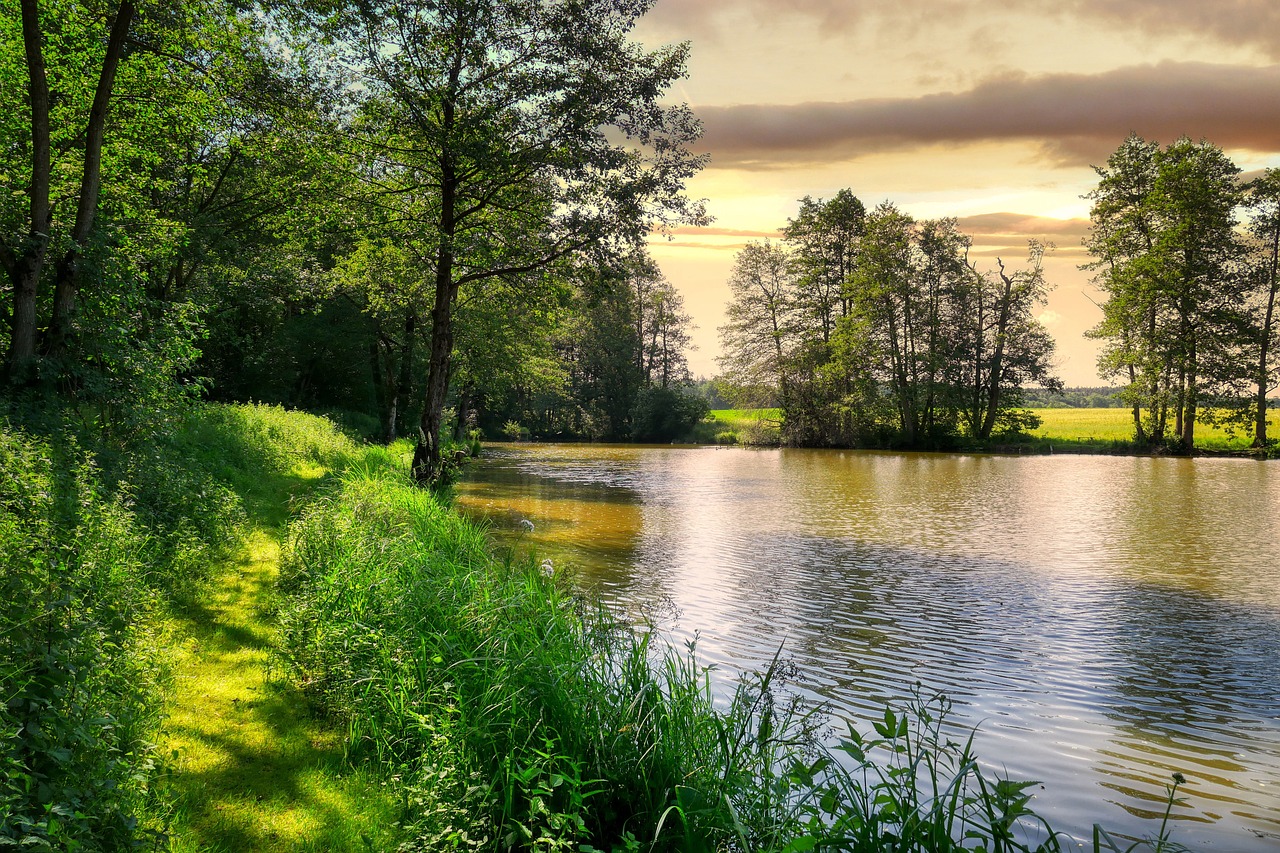Could Urban Ponds Play a Role in Stormwater Management?
Urban areas are often bustling with life, but they also face significant challenges when it comes to managing stormwater. With increasing rainfall and urbanization, cities are grappling with the consequences of flooding and pollution. However, one innovative solution gaining traction is the integration of urban ponds into stormwater management strategies. These ponds not only serve as beautiful green spaces but also play a crucial role in mitigating the adverse effects of stormwater runoff. In this article, we will dive deep into the potential benefits of urban ponds, their ecological impact, design considerations, and how community engagement can enhance their effectiveness in urban planning efforts.
Stormwater management is not just a buzzword; it's a necessity for urban areas facing the dual threats of flooding and pollution. When rain falls on concrete and asphalt, it doesn’t soak into the ground as it would in a natural environment. Instead, it rushes over surfaces, picking up pollutants and debris along the way, ultimately leading to contamination of waterways. Cities are increasingly recognizing the need for effective solutions to combat these issues. Without proper management, stormwater can overwhelm drainage systems, leading to severe flooding, property damage, and even health hazards. So, what can be done? Enter urban ponds—an effective and sustainable approach to managing stormwater.
Urban ponds offer a myriad of benefits that go beyond mere aesthetics. They can significantly contribute to sustainable urban environments by providing flood control, improving water quality, and creating habitats for local wildlife. Imagine a city where heavy rains no longer lead to flooded streets or polluted rivers. Instead, urban ponds act as natural sponges, absorbing excess rainwater and filtering out harmful pollutants. This not only protects local ecosystems but also enhances the quality of life for residents. But how exactly do these ponds achieve such remarkable outcomes? Let's explore further.
When it comes to flood control, urban ponds can function as vital components of a city's stormwater management plan. During heavy rain events, these ponds can absorb excess rainwater, significantly reducing the volume of runoff that would otherwise inundate streets and drainage systems. Consider them as nature's own flood control systems, designed to hold water temporarily and release it slowly, preventing overwhelming the infrastructure. By strategically placing ponds in urban areas, cities can lower the risk of flooding, protect properties, and enhance public safety.
The design of urban ponds is critical for their effectiveness. To maximize their stormwater management capabilities, several key principles should be considered:
- Natural Vegetation: Incorporating native plants around the pond can help filter pollutants and provide habitat for wildlife.
- Shallow Edges: Designing ponds with gently sloping edges can create diverse habitats and improve water quality through natural filtration.
- Multi-Functional Use: Ponds can serve multiple purposes, such as recreational areas for the community while also functioning as stormwater management systems.
By adhering to these principles, urban planners can create ponds that not only manage stormwater effectively but also promote biodiversity and enhance community spaces.
Regular maintenance is essential for urban ponds to function effectively. Neglecting these green spaces can lead to issues such as algae blooms, sediment buildup, and decreased water quality. Best practices for maintaining urban ponds include:
- Regularly removing debris and litter.
- Monitoring water quality to detect and address pollution sources.
- Managing vegetation to prevent overgrowth and maintain biodiversity.
By committing to ongoing maintenance, cities can ensure that urban ponds continue to provide their invaluable benefits for years to come.
Urban ponds play a significant role in improving water quality. As stormwater flows into these ponds, the natural filtration process occurs, where pollutants are trapped and decomposed by microorganisms. This not only enhances the health of the pond itself but also contributes to the overall health of urban waterways. Think of urban ponds as nature’s water treatment facilities, working tirelessly to cleanse the water before it re-enters rivers and lakes.
Community involvement is vital for the success of urban ponds. When residents understand the benefits of these ponds, they are more likely to support their creation and maintenance. Strategies for engaging residents in pond management include organizing community clean-up events, educational workshops, and creating volunteer programs. By fostering a sense of ownership and stewardship, communities can help ensure that urban ponds remain vibrant and functional.
Examining successful urban pond projects provides valuable insights into their effectiveness. For instance, the Greenway Pond project in Springfield transformed a neglected area into a thriving ecosystem that not only manages stormwater but also serves as a recreational space for the community. These case studies demonstrate that with the right planning and community involvement, urban ponds can deliver significant stormwater management benefits while enhancing local quality of life.
While urban ponds offer numerous advantages, they also face challenges. Issues such as land availability, funding, and public perception can hinder the implementation of urban pond projects. Moreover, if not designed and maintained properly, ponds can become sources of pollution themselves. It’s crucial for city planners to address these challenges head-on to realize the full potential of urban ponds in stormwater management.
Q: What are urban ponds?
A: Urban ponds are artificial or natural bodies of water located within urban areas, designed to manage stormwater and provide ecological benefits.
Q: How do urban ponds help with flooding?
A: Urban ponds absorb excess rainwater, reducing runoff and alleviating pressure on drainage systems during heavy storms.
Q: Are urban ponds safe for wildlife?
A: Yes! When designed correctly, urban ponds can create habitats for various species and promote biodiversity in urban settings.
Q: What maintenance do urban ponds require?
A: Regular cleaning, monitoring of water quality, and vegetation management are essential to keep urban ponds functional and healthy.

The Importance of Stormwater Management
Understanding stormwater management is crucial for urban areas that are increasingly facing challenges such as flooding and pollution. As cities grow, the natural landscape is often altered, leading to an increase in impervious surfaces like roads and buildings. These surfaces prevent water from soaking into the ground, resulting in higher volumes of runoff during rainfall. This runoff can overwhelm drainage systems, leading to flooding and the contamination of local waterways.
Moreover, stormwater carries pollutants such as oils, heavy metals, and debris into rivers and lakes, significantly degrading water quality. This is not just an environmental issue; it affects public health and local ecosystems. The need for effective stormwater management solutions has never been more pressing. As urban areas continue to expand, the importance of innovative strategies that can mitigate these problems becomes evident.
One of the most effective ways to address stormwater issues is through the implementation of sustainable practices. Urban ponds, for example, can act as natural reservoirs, capturing and slowly releasing stormwater, which reduces the burden on drainage systems. These ponds not only help manage excess water but also provide a habitat for wildlife, enhance biodiversity, and improve the aesthetic value of urban landscapes.
To grasp the full significance of stormwater management, consider the following key points:
- Flood Risk Reduction: Effective stormwater management systems can significantly decrease the risk of flooding in urban areas.
- Water Quality Improvement: Proper management practices can filter out pollutants before they reach larger bodies of water.
- Community Resilience: Well-designed stormwater systems contribute to the overall resilience of communities against climate change impacts.
In conclusion, the importance of stormwater management in urban planning cannot be overstated. It is essential for protecting both the environment and public health. As we look towards the future, integrating solutions like urban ponds into stormwater management strategies will not only address immediate challenges but also foster a more sustainable and resilient urban environment.

Benefits of Urban Ponds
Urban ponds are not just picturesque additions to city landscapes; they are vital components in modern stormwater management systems. These bodies of water bring a plethora of benefits that extend beyond mere aesthetics. Imagine walking through your neighborhood and seeing a vibrant pond teeming with life, all while knowing it plays a crucial role in protecting your home from flooding. Sounds appealing, right? Let's dive into the various advantages that urban ponds offer.
One of the primary benefits of urban ponds is their ability to provide flood control. During heavy rain events, these ponds act as natural reservoirs, absorbing excess rainwater that would otherwise overwhelm drainage systems. By capturing and holding this water, urban ponds can significantly reduce the risk of flooding in surrounding areas. They function like sponges, soaking up the deluge and releasing it slowly over time, which helps to maintain the natural hydrology of the area. This is especially crucial in cities where impervious surfaces like asphalt and concrete prevent water from soaking into the ground.
In addition to flood mitigation, urban ponds also contribute to water quality improvement. As rainwater flows over urban surfaces, it picks up a variety of pollutants, including oils, heavy metals, and nutrients. Urban ponds can filter these contaminants before they enter larger water bodies. The vegetation surrounding and within these ponds plays a key role in this process, as plants naturally absorb and break down harmful substances. This not only helps to keep our waterways cleaner but also supports the overall health of the local ecosystem.
Moreover, urban ponds foster biodiversity. They create habitats for various species, including fish, birds, and insects. The presence of these creatures can enhance the ecological function of urban areas, providing essential services such as pollination and pest control. When designed thoughtfully, urban ponds can serve as critical links in wildlife corridors, allowing animals to navigate through urban landscapes more easily. This biodiversity can also enrich the community's experience, offering opportunities for education and recreation.
To illustrate the multifaceted benefits of urban ponds, consider the following table that summarizes their key advantages:
| Benefit | Description |
|---|---|
| Flood Control | Absorbs excess rainwater, reducing urban flooding risks. |
| Water Quality Improvement | Filters pollutants, enhancing the health of urban waterways. |
| Biodiversity Support | Provides habitats for various species, promoting ecological balance. |
| Community Recreation | Offers spaces for leisure activities, fostering community engagement. |
Lastly, urban ponds can significantly enhance community well-being. They provide spaces for recreational activities, such as fishing, bird watching, and picnicking. These serene environments encourage residents to connect with nature, promoting mental health and community bonding. Imagine a sunny afternoon where families gather around a pond, children laughing as they feed the ducks, all while knowing that this beautiful spot also plays a role in managing stormwater. It's a win-win situation!
In summary, urban ponds are invaluable assets that contribute to sustainable urban living. They not only help manage stormwater effectively but also improve water quality, support biodiversity, and enhance community life. As cities continue to grow and face environmental challenges, integrating urban ponds into urban planning will be essential for creating resilient and vibrant communities.
- What are urban ponds? Urban ponds are artificial or natural bodies of water located within urban environments, designed to manage stormwater and provide ecological benefits.
- How do urban ponds help with flooding? They absorb excess rainwater during storms, reducing the volume of runoff and the likelihood of flooding in surrounding areas.
- Can urban ponds improve water quality? Yes, they filter out pollutants from stormwater, helping to keep local waterways cleaner.
- What types of wildlife can be found in urban ponds? Urban ponds can host various species, including fish, amphibians, birds, and beneficial insects.
- How can communities get involved with urban ponds? Communities can participate in pond management, educational programs, and recreational activities centered around these green spaces.

Flood Mitigation Strategies
Urban ponds are not just picturesque spots in the middle of a bustling city; they are powerful allies in the fight against flooding. Imagine a sponge soaking up rainwater—this is essentially what urban ponds do during heavy storms. When rain falls, especially in urban areas with impervious surfaces like concrete and asphalt, water can quickly accumulate and lead to flooding. Here’s where urban ponds come into play. They act as natural flood control systems, capturing and storing excess rainwater, which significantly reduces the risk of urban flooding.
But how exactly do these ponds manage to mitigate floods? First off, they provide a temporary storage solution for stormwater. During a heavy downpour, urban ponds can collect runoff from surrounding areas, allowing it to slowly seep into the ground rather than overwhelming drainage systems. This delayed release of water helps prevent the usual surge that can cause flooding downstream. Additionally, the design and depth of these ponds can be tailored to maximize their capacity for handling stormwater, ensuring that they can accommodate varying rainfall intensities.
Moreover, the vegetation surrounding urban ponds plays a crucial role in flood mitigation. Plants not only beautify the area but also help absorb water. The roots of these plants stabilize the soil, reducing erosion and allowing for better infiltration of water into the ground. This natural process can significantly decrease surface runoff, making urban landscapes more resilient to flooding. In fact, studies have shown that well-designed urban ponds can reduce peak runoff rates by as much as 50% during significant storm events.
In addition to their immediate flood mitigation benefits, urban ponds can also contribute to long-term urban planning strategies. By integrating these natural features into city designs, urban planners can create a network of green spaces that not only manage stormwater but also enhance the aesthetic and recreational value of neighborhoods. Think of urban ponds as multifunctional spaces that serve both ecological and social purposes.
However, it's important to note that the effectiveness of urban ponds in flood mitigation depends on proper design and maintenance. A poorly designed pond might not capture enough water, or it could become clogged with debris over time. Therefore, cities must prioritize regular maintenance and community involvement to ensure these ponds remain effective. Engaging local residents in the upkeep of these ponds can foster a sense of ownership and responsibility, further enhancing their role in stormwater management.
In summary, urban ponds are a vital component of flood mitigation strategies in urban areas. Their ability to store excess rainwater, combined with the ecological benefits they offer, makes them an essential tool for cities facing the challenges of increased rainfall and urbanization. By incorporating these natural systems into urban planning, we can not only protect our communities from flooding but also create beautiful, thriving environments for all to enjoy.
- What are urban ponds? Urban ponds are man-made or natural water bodies designed to manage stormwater, enhance biodiversity, and provide recreational spaces in urban settings.
- How do urban ponds help with flooding? They absorb excess rainwater, reducing runoff and lowering the risk of flooding in surrounding areas.
- What maintenance do urban ponds require? Regular cleaning, vegetation management, and monitoring water quality are essential for maintaining their effectiveness.
- Can urban ponds improve water quality? Yes, they filter out pollutants from stormwater, helping to improve the overall health of urban waterways.
- How can communities get involved? Residents can participate in pond clean-ups, educational programs, and advocacy for sustainable urban planning.

Designing Effective Ponds
When it comes to designing effective urban ponds, the goal is not just to create a pretty water feature; it's about integrating these ponds into the urban ecosystem in a way that maximizes their stormwater management capabilities. Imagine a sponge soaking up rainwater during a downpour—this is essentially how a well-designed pond functions. The design process involves several critical considerations that ensure these ponds serve their intended purpose while also enhancing the beauty and biodiversity of urban landscapes.
First and foremost, the location of the pond is paramount. It should be strategically placed in areas prone to flooding or where runoff is significant. This could be near roads, parking lots, or other impervious surfaces that contribute to stormwater runoff. The pond's size and depth are also crucial; they need to be large enough to hold excess water during heavy rains but not so deep that they become hazardous or difficult to maintain. A common design feature is to have varying depths, which can create different habitats for wildlife and improve the pond's ecological function.
Another key aspect is the vegetation surrounding and within the pond. Native plants are often the best choice, as they are adapted to local conditions and provide food and shelter for various species. These plants also play a vital role in filtering pollutants from the water. For instance, wetland plants like cattails and bulrushes can absorb excess nutrients and improve water quality. A well-planned vegetative buffer around the pond can also help reduce erosion and provide a natural habitat for wildlife.
Furthermore, the inflow and outflow structures must be carefully designed to manage water levels effectively. This includes creating inlet and outlet channels that can handle varying volumes of water. During heavy rains, these channels should be able to direct excess water into the pond without causing overflow or flooding in other areas. On the flip side, during dry spells, the design should ensure that water does not stagnate, which can lead to unpleasant odors and mosquito breeding.
To illustrate the various design elements, the following table summarizes the key features and their corresponding benefits:
| Design Element | Benefit |
|---|---|
| Location | Reduces flooding in vulnerable areas |
| Size and Depth | Accommodates varying stormwater volumes |
| Vegetation | Improves water quality and habitat |
| Inflow/Outflow Structures | Maintains optimal water levels |
Finally, effective pond design also incorporates community input. Engaging local residents in the design process not only fosters a sense of ownership but also ensures that the pond meets the needs of the community. This could involve organizing workshops or brainstorming sessions where residents can share their ideas and preferences. After all, these ponds are not just functional features; they are also places for recreation, education, and community gathering.
In conclusion, designing effective urban ponds requires a holistic approach that considers location, size, vegetation, water management structures, and community engagement. When done right, these ponds can transform urban landscapes into vibrant, functional ecosystems that play a significant role in stormwater management.

Maintenance Considerations
Maintaining urban ponds is not just about keeping them looking pretty; it’s about ensuring they function effectively as stormwater management tools. Regular maintenance is essential for these ecosystems to thrive and continue providing their myriad benefits. Think of it like keeping a garden healthy; if you neglect it, the weeds will take over, and the plants won’t flourish. So, what does proper maintenance involve?
First and foremost, regular inspections are crucial. These inspections help identify any issues such as debris accumulation, erosion, or water quality problems early on. Visual checks can reveal a lot—if the water looks murky or there’s an unpleasant odor, it could indicate that something is off. Additionally, monitoring the pond's vegetation is vital. Native plants should be encouraged, as they help stabilize the banks and filter pollutants. Non-native or invasive species, on the other hand, can disrupt the ecosystem, so they should be controlled or removed.
Another key aspect of maintenance is sediment management. Over time, sediment can build up in urban ponds, reducing their capacity to hold water and filter pollutants. Regular dredging may be necessary to remove excess sediment and maintain the pond's depth. This process not only helps with flood mitigation but also enhances the pond's aesthetic appeal.
Moreover, water quality testing should be part of the routine maintenance schedule. Testing for parameters such as pH, turbidity, and nutrient levels can provide insights into the health of the pond. If pollutants are detected, swift action is required—this might involve adjusting the landscaping around the pond to reduce runoff or installing additional filtration systems.
To ensure a sustainable maintenance plan, it’s essential to involve the community. Engaging local residents in pond care can foster a sense of ownership and responsibility. Organizing volunteer days for clean-ups or educational workshops can be a fun and effective way to involve the community. After all, when people feel connected to their environment, they are more likely to take care of it.
In conclusion, maintaining urban ponds requires a proactive approach that includes regular inspections, vegetation management, sediment control, water quality testing, and community involvement. By prioritizing these maintenance considerations, urban ponds can continue to serve their vital role in stormwater management and contribute positively to the urban ecosystem.
- How often should urban ponds be maintained? Regular inspections should be conducted at least twice a year, with more frequent checks during heavy rain seasons.
- What are the signs that a pond needs maintenance? Signs include murky water, unpleasant odors, excessive algae growth, and accumulation of debris.
- Can the community get involved in maintaining urban ponds? Absolutely! Community engagement is crucial. Organizing clean-up events and educational workshops can help foster a sense of ownership.
- What is sediment management, and why is it important? Sediment management involves removing excess sediment from the pond to maintain its depth and filtering capabilities, essential for effective stormwater management.

Water Quality Improvement
Urban ponds are not just pretty additions to our city landscapes; they play a vital role in enhancing water quality in urban areas. Imagine a sponge soaking up rainwater, filtering it, and releasing clean water back into the environment. That’s essentially what urban ponds do! They act as natural filtration systems, capturing pollutants and sediments that would otherwise flow directly into our rivers and lakes during storm events.
One of the primary ways urban ponds improve water quality is through the process of sedimentation. When stormwater flows into these ponds, the speed of the water decreases, allowing heavier particles like silt and debris to settle at the bottom. This natural settling process reduces the amount of pollutants that enter larger water bodies, making the water cleaner and healthier for aquatic life.
Moreover, urban ponds facilitate the growth of beneficial microorganisms and aquatic plants, which can further purify the water. These organisms consume nutrients such as nitrogen and phosphorus, which are often responsible for algae blooms that can suffocate aquatic ecosystems. By absorbing these excess nutrients, urban ponds help maintain a balanced ecosystem. To illustrate this, consider the following table that highlights the key roles of urban ponds in water quality improvement:
| Role | Description |
|---|---|
| Sedimentation | Reduces particle pollution by allowing sediments to settle. |
| Nutrient Absorption | Removes excess nutrients to prevent harmful algae blooms. |
| Habitat Creation | Provides a habitat for beneficial microorganisms and plants that filter water. |
In addition to these natural processes, urban ponds also serve as a buffer during heavy rainfall events. They can temporarily store excess stormwater, which not only reduces flooding risk but also gives the water time to percolate through the soil and be filtered naturally. This means that the water that eventually flows out of the pond is much cleaner than the stormwater that entered it.
However, it’s essential to recognize that maintaining the water quality benefits of urban ponds requires ongoing effort. Regular monitoring and maintenance are crucial. This includes removing accumulated sediments, controlling invasive species, and ensuring that the surrounding environment remains healthy. Engaging the community in these efforts can foster a sense of ownership and responsibility, making it easier to maintain the ponds and their water quality benefits.
In summary, urban ponds are invaluable assets in the quest for improved water quality in urban settings. They not only filter pollutants but also provide habitats for diverse wildlife, contributing to a more sustainable urban ecosystem. As cities continue to grow, integrating more urban ponds into stormwater management plans could be a game changer for both our environment and our communities.
- How do urban ponds filter water? Urban ponds filter water through natural processes like sedimentation and nutrient absorption by plants and microorganisms.
- Can urban ponds help reduce flooding? Yes, urban ponds can temporarily store excess stormwater, reducing the risk of flooding in urban areas.
- What maintenance do urban ponds require? Regular maintenance includes removing sediments, controlling invasive species, and monitoring water quality.
- Are urban ponds beneficial for wildlife? Absolutely! Urban ponds provide critical habitats for various aquatic and terrestrial species.

Community Engagement and Education
Community engagement is a vital component in the success of urban ponds as effective stormwater management systems. When local residents take an active role in the planning, development, and maintenance of these ponds, it fosters a sense of ownership and responsibility that can lead to better care and sustainability. But how can communities get involved? Well, it starts with education. By understanding the ecological benefits and the role of urban ponds in their neighborhoods, residents can become advocates for their protection and enhancement.
One effective way to engage the community is through workshops and informational sessions. These gatherings can serve as platforms for residents to learn about stormwater management and the specific benefits urban ponds provide, such as:
- Flood control: Understanding how ponds can mitigate flooding risks during heavy rain events.
- Water quality: Learning about the filtration processes that urban ponds employ to improve water quality.
- Biodiversity: Recognizing the habitats that ponds create for various species, contributing to urban biodiversity.
Moreover, involving local schools in educational programs can instill a sense of environmental stewardship in younger generations. Imagine students participating in pond clean-up days or planting native vegetation around the ponds! Such activities not only provide hands-on experience but also create lasting memories and a deeper connection to their local environment.
Another strategy for community engagement is to establish volunteer groups dedicated to the upkeep of urban ponds. These groups can organize regular maintenance activities, such as removing debris, monitoring water quality, and planting native species. Not only does this keep the ponds functioning optimally, but it also builds a community of like-minded individuals who care about their local environment.
To further enhance community involvement, cities can utilize social media and local newsletters to share updates about urban pond projects. This ensures that residents are informed about ongoing activities, upcoming events, and the overall health of their local ponds. Transparency in communication fosters trust and encourages more people to get involved.
In summary, community engagement and education are critical for the successful implementation and maintenance of urban ponds. By fostering a culture of involvement and awareness, cities can create vibrant ecosystems that not only manage stormwater effectively but also enrich the lives of their residents.
| Question | Answer |
|---|---|
| How can I get involved with my local urban pond project? | You can start by attending community meetings, joining volunteer groups, or participating in educational workshops. |
| What are the main benefits of urban ponds? | Urban ponds help with flood control, improve water quality, and provide habitats for wildlife. |
| Are urban ponds safe for recreational activities? | Yes, as long as they are properly maintained and monitored for water quality, urban ponds can be safe for activities like fishing and picnicking. |

Case Studies of Successful Urban Ponds
Urban ponds are not just aesthetic additions to city landscapes; they can be transformative elements in stormwater management strategies. To illustrate their potential, let’s delve into a few successful case studies that highlight how urban ponds have made a significant impact in various cities.
One standout example is the Lake Merritt in Oakland, California. This tidal lagoon not only serves as a recreational area but also plays a critical role in managing stormwater runoff. The city implemented a series of improvements to enhance the pond's ability to filter pollutants while providing a habitat for local wildlife. The results have been remarkable: flooding events have decreased significantly, and water quality has improved, making it a beloved spot for both residents and migratory birds.
Another impressive case is the Stormwater Park in Portland, Oregon. This innovative project integrates a series of ponds and bioswales designed to capture and treat stormwater before it enters the Willamette River. The park has become a model for sustainable urban design, showcasing how green infrastructure can coexist with urban development. Through community involvement and educational programs, residents have become stewards of this space, understanding the vital role it plays in their environment.
In Chicago, the Humboldt Park Ponds have undergone revitalization efforts that have turned them into effective stormwater management systems. By creating a series of interconnected ponds, the city has enhanced its capacity to manage heavy rainfall events. The design incorporates native vegetation, which not only beautifies the area but also aids in filtering out pollutants. Community workshops have educated locals on the ecological benefits of these ponds, fostering a sense of ownership and pride.
These case studies reveal a common thread: when urban ponds are designed with purpose and backed by community engagement, they can significantly enhance urban resilience against stormwater challenges. They serve as a reminder that cities can harmoniously blend nature with infrastructure, creating spaces that are not only functional but also enriching for the community.
To summarize, the benefits of urban ponds are evident in these successful implementations. They provide crucial flood mitigation, improve water quality, and foster community involvement. As cities continue to grapple with the impacts of climate change, these case studies serve as a beacon of hope, showcasing that with thoughtful design and community collaboration, urban ponds can be a vital part of sustainable urban planning.
- What is the primary purpose of urban ponds? Urban ponds primarily serve to manage stormwater, improve water quality, and provide habitats for wildlife.
- How do urban ponds help with flood control? They absorb excess rainwater, reducing runoff and the risk of urban flooding during heavy storms.
- Can urban ponds improve community engagement? Yes, urban ponds often serve as focal points for community activities, education, and stewardship, fostering a connection between residents and their environment.
- What are some challenges in maintaining urban ponds? Challenges include pollution, invasive species, and the need for regular maintenance to ensure their effectiveness.

Challenges and Limitations
While urban ponds offer a plethora of benefits for stormwater management, they are not without their . Understanding these obstacles is crucial for urban planners, environmentalists, and community members who aim to implement effective solutions. One significant challenge is the space constraint in densely populated urban areas. Real estate is at a premium, and finding suitable locations for new ponds can be a daunting task. Moreover, even if space is available, the existing infrastructure may not support the integration of ponds without significant modifications.
Another limitation lies in the maintenance requirements. Urban ponds require ongoing care to remain functional and beneficial. This includes regular cleaning to prevent debris accumulation, as well as monitoring water quality to ensure it remains healthy for both wildlife and the community. Without proper maintenance, ponds may become stagnant or polluted, ultimately defeating their purpose. Additionally, funding for such maintenance can be a hurdle, as municipalities often face budget constraints that limit their ability to allocate resources for these projects.
Furthermore, public perception can pose a challenge. Some community members may view urban ponds as potential breeding grounds for mosquitoes or as unsightly features that detract from property values. Overcoming these misconceptions requires effective community engagement and education initiatives that highlight the ecological and social benefits of urban ponds. Engaging residents in the planning process can help foster a sense of ownership and appreciation for these natural features.
Another aspect to consider is the ecological impact of urban ponds. While they can enhance biodiversity, poorly designed ponds may inadvertently disrupt local ecosystems. For instance, if the pond is not properly integrated into the surrounding landscape, it might attract non-native species that outcompete local flora and fauna. This can lead to a decline in native biodiversity, which is counterproductive to the goals of sustainable urban planning.
Finally, climate change introduces an additional layer of complexity. As weather patterns become increasingly unpredictable, urban ponds must be designed to handle extreme weather events, such as heavy rainfall or prolonged droughts. This requires innovative design solutions and ongoing research to understand how urban ponds can adapt to changing conditions.
In summary, while urban ponds hold great potential for enhancing stormwater management, it is essential to recognize and address the challenges and limitations they present. By doing so, we can create more resilient urban environments that benefit both people and nature.
- What are the primary benefits of urban ponds?
Urban ponds help manage stormwater, improve water quality, and create habitats for wildlife. - How do urban ponds mitigate flooding?
They absorb excess rainwater, reducing runoff and the risk of urban flooding during heavy storms. - What maintenance do urban ponds require?
Regular cleaning, water quality monitoring, and community engagement are essential for their upkeep. - Can urban ponds attract pests?
Yes, if not properly maintained, they may attract mosquitoes, but education can help mitigate these concerns. - How does climate change affect urban ponds?
Urban ponds must be designed to withstand extreme weather events, requiring innovative planning and design.
Frequently Asked Questions
- What is the role of urban ponds in stormwater management?
Urban ponds act as natural buffers, absorbing excess rainwater and reducing the risk of flooding in urban areas. They help manage stormwater by slowing down runoff and allowing water to filter through the soil, which can significantly decrease the volume of water that enters drainage systems.
- How do urban ponds improve water quality?
Urban ponds play a crucial role in filtering pollutants from stormwater. They trap sediments and absorb nutrients, which helps to enhance the overall health of urban waterways. This natural filtration process can lead to clearer, cleaner water, benefiting both the ecosystem and local communities.
- What are the key design considerations for effective urban ponds?
Designing effective urban ponds involves several key principles, including proper sizing, depth, and vegetation selection. It’s important to create a balance between aesthetics and functionality, ensuring that ponds are not only visually appealing but also capable of managing stormwater efficiently while supporting biodiversity.
- How can communities get involved in the management of urban ponds?
Community engagement is vital for the success of urban ponds. Residents can participate in management efforts through volunteer clean-up days, educational workshops, and by advocating for sustainable practices in local planning. This involvement fosters a sense of ownership and responsibility towards these vital resources.
- What challenges do urban ponds face?
While urban ponds offer numerous benefits, they also encounter challenges such as pollution, invasive species, and maintenance issues. These obstacles can hinder their effectiveness and require ongoing community and municipal support to ensure they remain functional and beneficial for stormwater management.
- Can urban ponds support local wildlife?
Absolutely! Urban ponds can create habitats for various species, including birds, amphibians, and beneficial insects. By incorporating native plants and creating diverse environments, these ponds can enhance local biodiversity and provide essential resources for wildlife in urban settings.



















